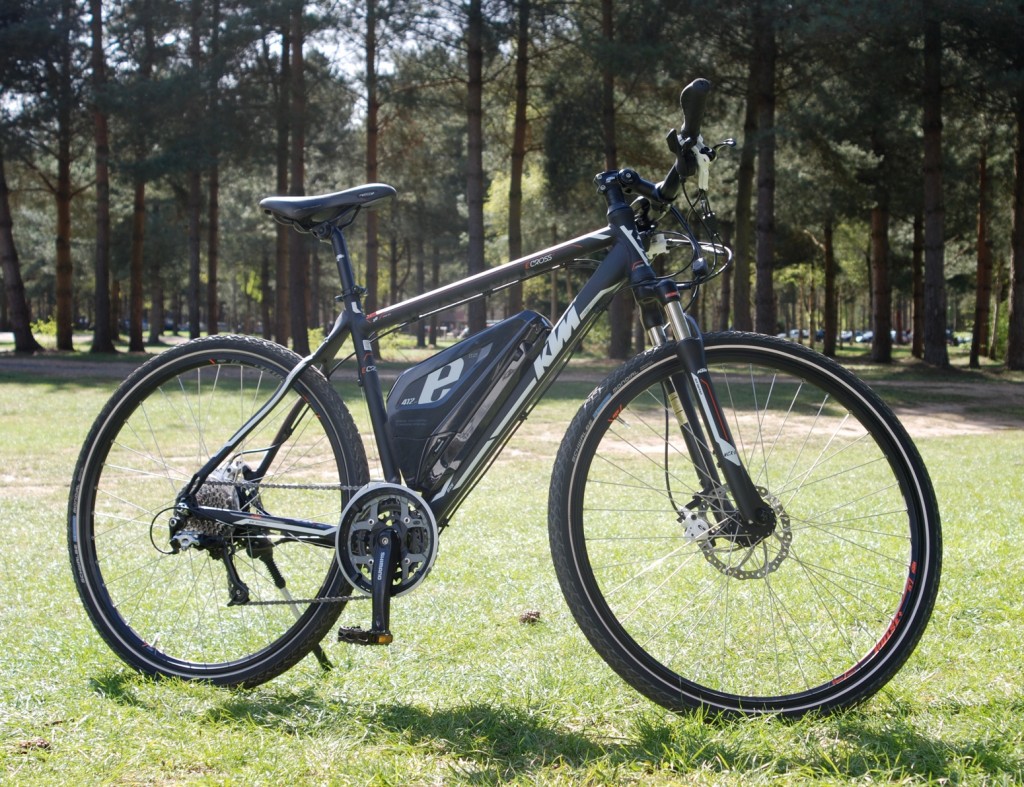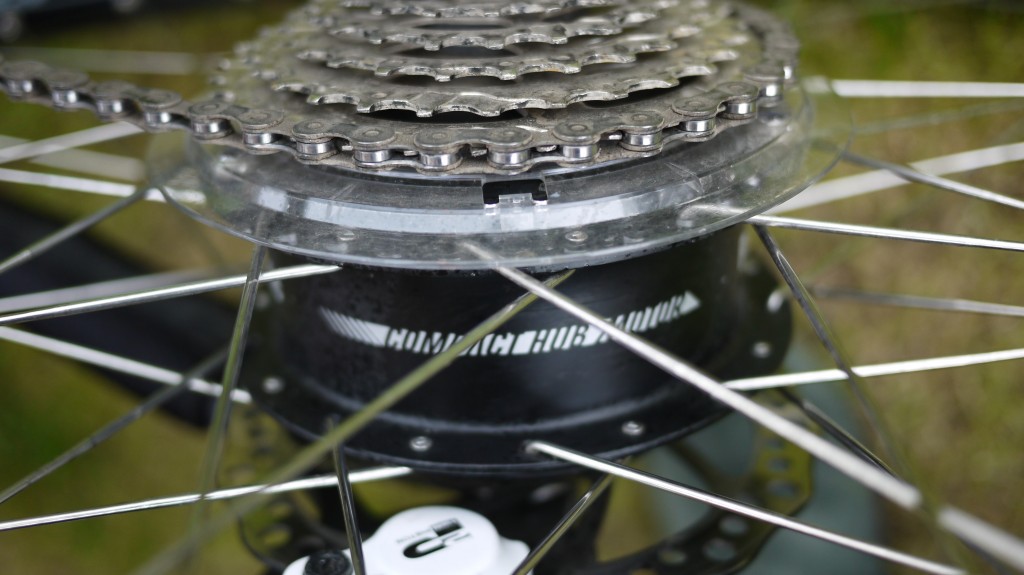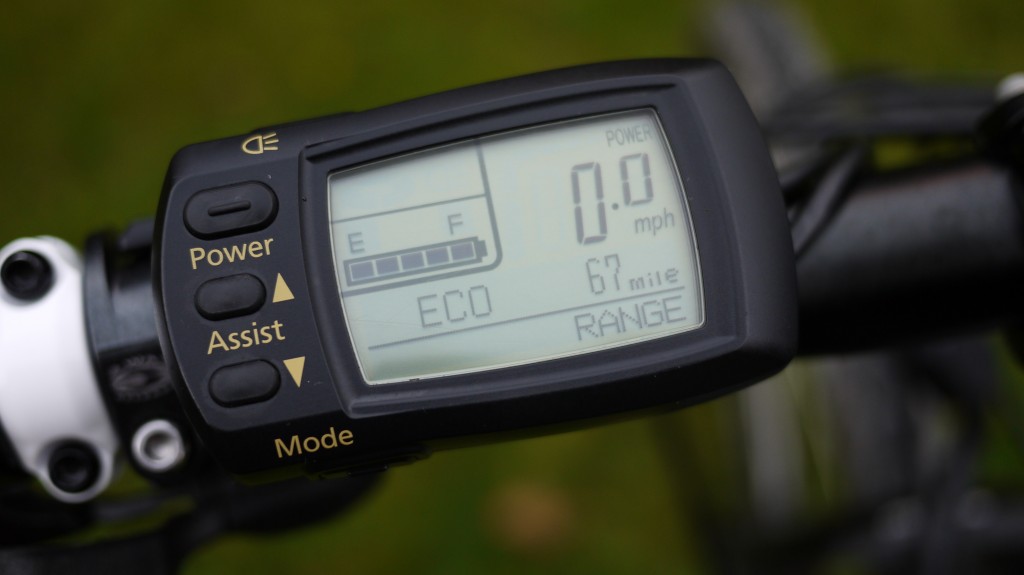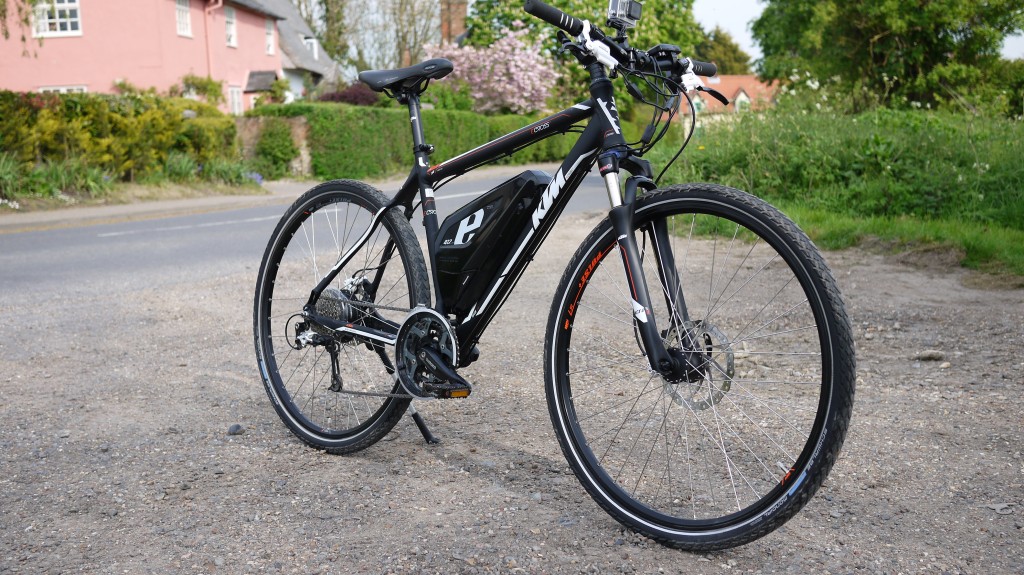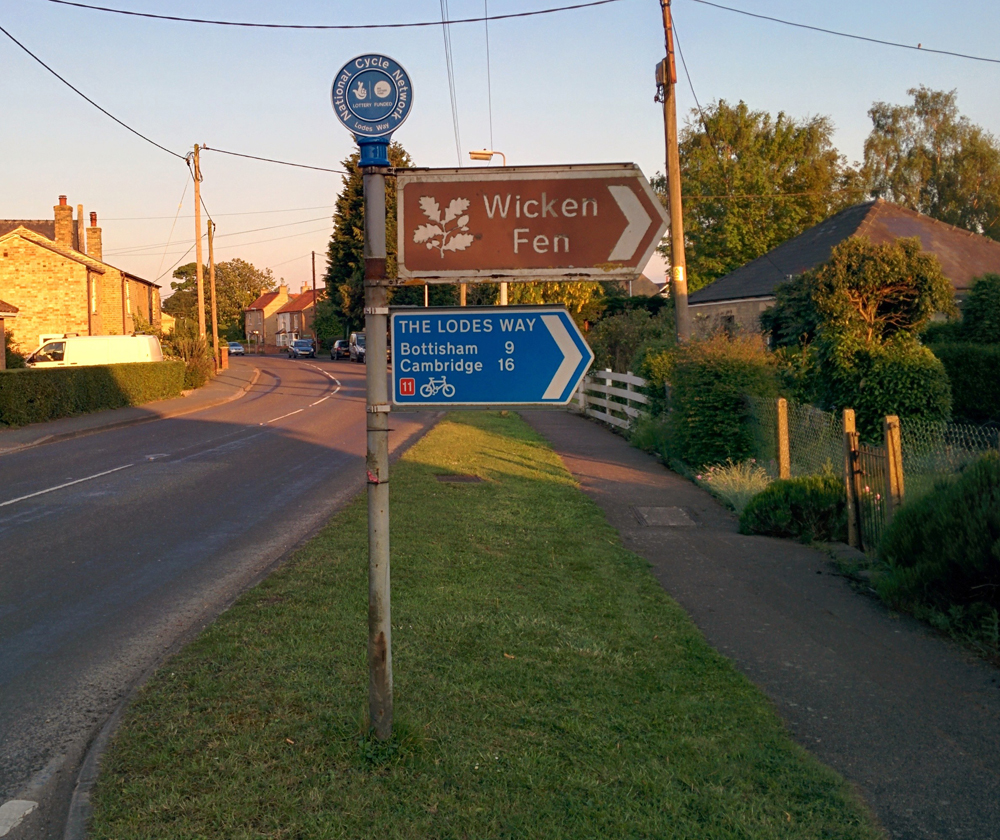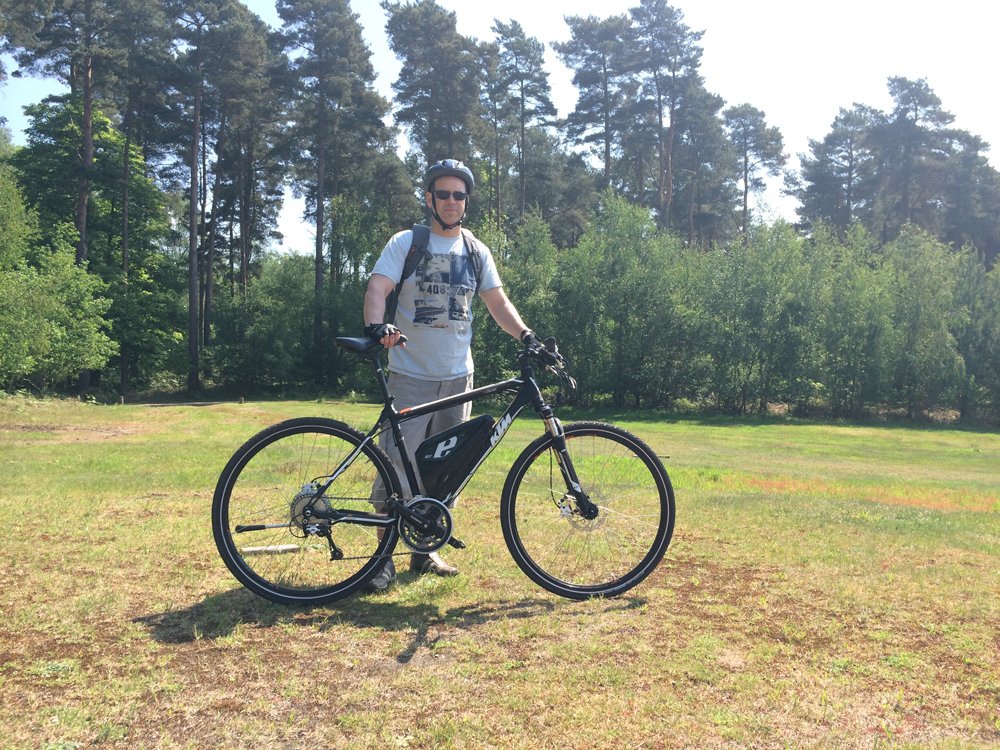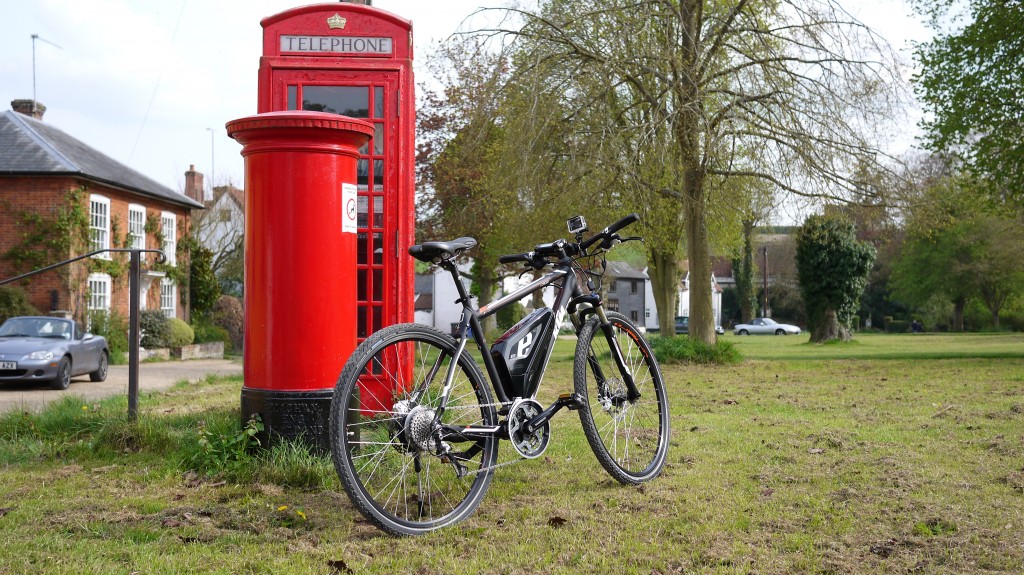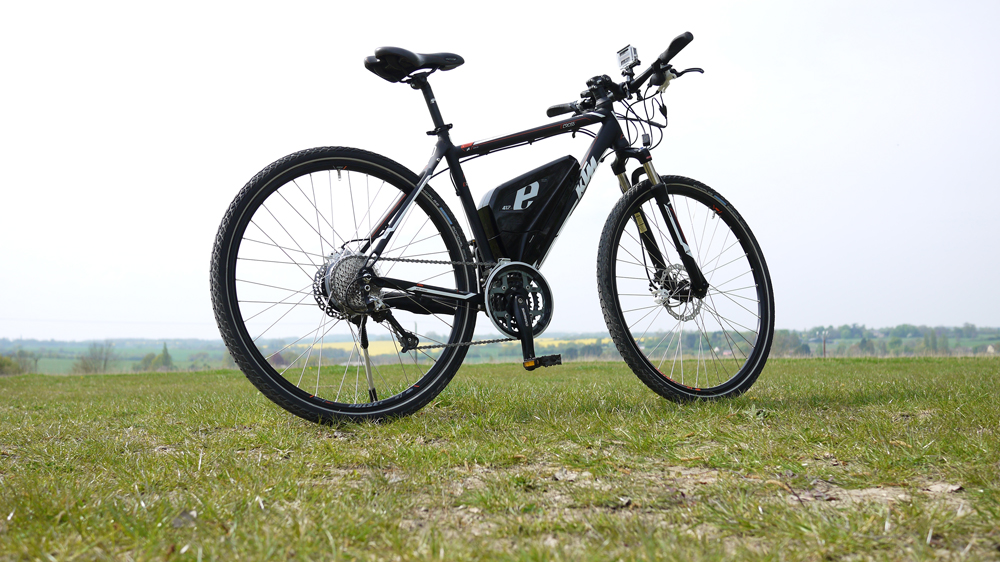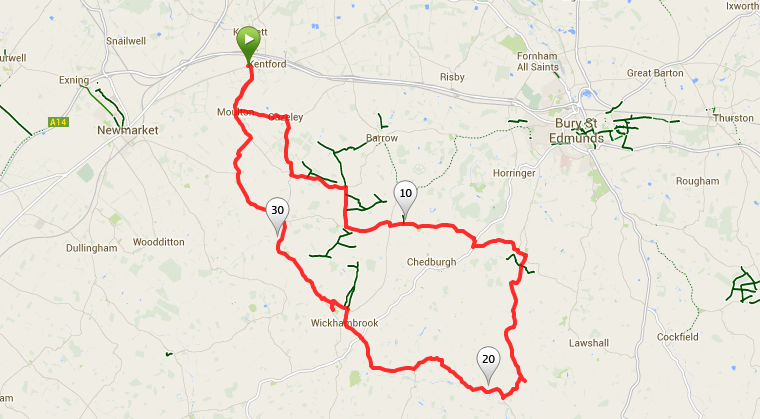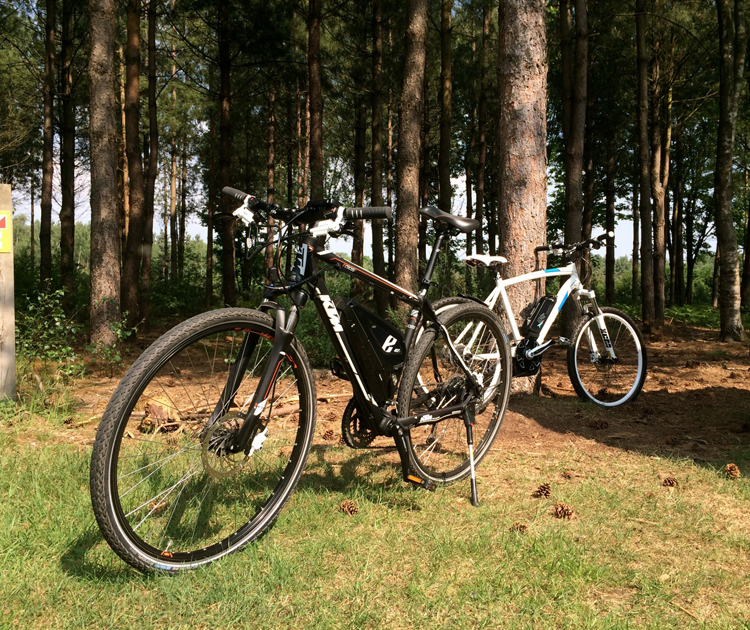Here at Pedelecs we’ve put the latest Panasonic-equipped eCross P from KTM through its paces to tell you how it performs on multiple surfaces.
Introduction
If you found this review and you are completely new to electric bikes, then it might be worth reading our introductory articles first, our First Timers’ section is here and our Buyers’ Guides section is here.
A little bit about KTM
Who are KTM? Motorbikes spring to mind when I think of KTM, but they have actually been producing (and racing) bicycles over the last four decades. Although the company has been making bicycles since 1964, they have only recently dived into the electric bike world. You can read more about KTM’s history and how their bikes are produced here.
The brand now boasts a range of over 30 electric bikes, with the eCross P (the ‘P’ in this instance standing for Panasonic) first launched in 2012, however this model has been updated with the latest Panasonic compact hub motor system.
The bike
The eCross is a hybrid bike that is at home offroad on the trails and cycle paths as well as commuting by road.
If you are commuter however, it’s worth noting it doesn’t come with lights, mudguards or a rack, so you would need to add these yourself. The bike does come with eyelets in the frame and fork for fitting these however.
The bike is powered by a rear Panasonic hub motor, which was developed as a joint collaboration between KTM and Panasonic. The 47V motor is rated at 250W and provides up to 40 Nm of power. The bulk of the electronics in the motor have been moved to the battery area to protect the motor from excessive heat, less heat meaning optimum performance on the hills.
Other advantages are that this brings the motor weight down to a mere 2.7 Kg and the size of the hub motor down to 140mm, it’s barely bigger than the cassette. Apart from the battery, you’d be hard pressed to tell it’s an electric bike. It’s powered by a triangular 8.8Ah 400Wh lithium battery set in the frame. The battery can be charged on or off the frame using the supplied charger.
Panasonic have a good heritage in electric bikes stemming from the Lafree bikes (the mere mention of which elicits a fondness from a number of previous owners on the forum) and the compact hub motor used here is exclusive to KTM.
Designed for the European market, it’s a pedal assist only bike, so there is no throttle or walk-along mode. There is a control unit on the left handlebar that allows you to set the various levels of assistance, offering four options of ‘eco,’ ‘standard,’ ‘high’ and of course ‘off’.
In terms of the power each setting can assist you by, these are the percentages:
- High: 400%
- Standard: 150%
- Eco: 90%
- Auto: variable
There are also 3 regenerative braking modes (‘regen’) to put some extra juice back into the battery if you find yourself on a long downhill stretch.
KTM eCross specification:
- Motor power (W): 250
- Motor position: Rear hub
- Motor description: Panasonic Hubmotor PCT 47v – 250w
- Battery: Panasonic Akku 47v / 8.8ah = 414Wh
- Max range: 90 miles
- Throttle / Pedal Assist: Pedal assist only, no throttle
- Suspension: Front
- Brakes: Tektro Auriga Hydraulic disc
- Gears: 27
- Stem: KTM Line AS-820, 31.8
- Saddle: KTM VL-3257
- Wheel size (in): 700
- Tyres: Schwalbe Marathon Mondial 40-622
- Controls: Shimano Deore XT
- Fork: Suntour SF14 NCX-D LO 700c
- Handlebars: KTM Line JD-442A Lowriser 31.8/620 – Ergon Grip
For more details on the KTM eCross specification click here.
What’s in the box
So once your larger-than-life-size cardboard box has been dropped off by the courier, what’s inside?
What comes with the bike:
- Manual
- Charger
- Battery
All you need to do to assemble the bike is attach the pedals, check over the various components, charge the battery and go.
First impressions
It looks even better in the flesh! There’s the striking colour scheme, matt powder black frame with orange and white decals, it’s not too outlandish and it makes the bike look expensive. It’s spot on in my opinion, the designers at KTM have really crafted a look for the brand that is distinctive and stylish.
Your hard earned cash gets you a number of decent components including Shimano Deore XT shifters/derailleur and Tektro Auriga hydraulic disk brakes. There is also an adjustable stem to allow you to adjust your preferred riding position.
The battery is quite large and, at first, I was a bit put off having got used to the slimline batteries on our Bosch equipped bikes. But it did grow on me and by the end of its time with me, I no longer noticed it, apart from the big ‘E’ to remind you! The charger, when plugged into the bike, is silent. A button and 5 LEDs on the battery gives you an indication of how much charge is left.
It’s also good to see KTM fit decent Schwalbe Mondial tyres as standard and they performed as I expected throughout the review period.
The console gives you the following readings : Speed, average speed, max speed, total miles, trip miles, power level, regen level and the range left in your battery. Sadly, it is not removable.
So that’s the first impressions of the bike out of the box, so now out on the road for the real test.
Test ride diary
Since this is a hybrid electric bike, designed for multiple terrains, I decided to try the bike out on different surfaces and routes across several days.
Ride 1 – Out for the first spin
First for a quick ride round the village to get used to it. The bike accelerates swiftly up to the 15.5mph cut-off, the motor cutting out is very smooth with an almost imperceptible cut-off point. There is no ‘overrun’ like you can find on other bikes, although the speedo is about 0.5 mph out according to several of my sat-nav devices. So an indicated 15.5mph is actually around 16.1 mph which is within the acceptable 10% tolerance limt. The eCross is pedelec only, the torque sensor incorporated into the bottom bracket.
There is a slight whine to the motor which is more apparent at lower speeds or when from a standing start, but once you’re moving you can hardly hear it. Being driven by a hub, it is a completely different soundtrack to the crank drives such as Bosch. It is a pleasant noise though. At full speed in light winds, if you turn your head you can hear just a quiet hum in the background.
The power modes switch easily between eco, standard, auto and high via the control panel on the handlebar. The ‘auto’ assist is variable and the bike adjusts the assistance according to your effort and ride conditions. The buttons on the control are quite small though and I would imagine be fiddly to operate in the winter months. I also felt the power settings were in the wrong order especially when going downhill and wanting to select one of the regen modes (more on this later).
While riding, there is a power meter on the console to give you an indication of how much the motor is assisting you.
Gearing is provided by Shimano Deore XT, giving you 27 gears, 9 on the rear and a triple chain set (48-36-26) on the front. From a standing start, changing up quickly through the gears was smooth and precise. One of the benefits of a hub motor is there is less stress on the gearing.
The Shimano Tektro Auriga hydraulic disk brakes provided plenty of progressive stopping power.
Ride 2 – Fen Ride
Day two and time to put the bike to a more serious test.
Living near Newmarket, but working in Cambridge, I decided to try out an alternative fen route for my commute using the Sustrans national cycle network route.
Joining the route at Wicken Fen, the terrain is a mixture of rough and tarmac cycle paths, which the front forks soaked up easily enough.
The Panasonic motor is quick off the mark, with only a gentle whine from the motor. Great handling; trails is what this bike is built for. Cattle grids, rough stones didn’t faze it one bit. The Fens are extremely flat, so there aren’t any hills around here to try out the climbing capabilities of this bike today, unfortunately.
The cycle route ended near Bottisham lock, meaning I had to dismount for the next few hundred yards. Obstacles in the form of styles and gates and a couple of locks meant I had to dismount and lift the bike several times . You notice the extra weight of an e-bike when lifting it several times in quick succession. At roughly 21Kg, this certainly isn’t the heaviest e-bike out there however.
On the return I realised I’d had the wind with me the entire way, so it was a bit of a shock to face a 25mph headwind on the way back.
Being the fens, it’s open countryside and the wind roars through. The bike was unfazed by this however and handled the 26 mile route with ease. I still had two bars left on the display’s battery level status. The last few miles home were on a busy A road, no problems for the bike there.
Ride 3 – Thetford Forest trails
Day three and I decided to take the eCross for a bit of off-road. I chose the Lime Burner trail at Thetford Forest park which consists of a 8 mile circular route with a tight sweeping single track. While the track has been downgraded from black to red, there are still plenty of crests, dips and bomb holes to challenge the bike.
The Beast, in the latter stages of the trail was a lot of fun with lots of big ups and downs and drops over rocks and roots. This proved to be a bigger challenge for the bike however as it has no rear suspension and the extra unsprung weight from a rear hub motor made it a bone-shaking ride. While the 63mm NCX-D LO coil forks make light work of road and trails, the twists, turns and tree roots highlighted their limitations here. The eCross is therefore ideal for family trails but not hardcore MTB trails. For those wanting more serious off-road capabilities, there are other models in the KTM range better suited such as the eLycan which comes with Rockshox Revelation forks and rear suspension. However, this will empty your wallet of a further £700.
One aspect of this rear hub driven bike is what I would term ‘turbo lag’. The power would continue to assist for a couple of seconds after I stopped pedalling. This was useful in the tight hairpins amongst the trees as I could effectively ‘power’ out of the corners! That said, the bike’s powerful motor and rear-drive provided plenty of traction.
Ride 4 – Head for the hills
Day four and I’m in search of East Anglia’s elusive hills. I start at Moulton, near the historic town of Newmarket and the home of horse racing.
South of the Newmarket ridge is the highest point in this county. I headed straight up the first hill. The KTM made light work of it and I settled down into a comfortable cruise at the legal speed limit. A few rolling hills later and out on to the B roads and a squeaking developed – luckily just the headset needed tightening, so it’s minor.
This bike is definitely aimed at flattening hills. If I changed up a gear on hills, I found it could easily add an extra couple of mph towards the legal limit which was surprising and welcoming. On declines, you can use the ‘engine braking’ function to a) put some power back into the battery and b) slow you down. Do this by gently pulling on the brakes, a harder pull will utilise the hydraulic discs. I found this feature particularly useful.
The highest point along the way was just over 404ft above sea level. A few miles later and the village of Hartest provides our steepest climb of the day with a section said to to be 17% gradient, so a good test for the hub motor. For the first attempt I wanted to see how fast I could climb it and with a bit of effort managed to average 15mph over the climb. A non-powered rider was just beginning his ascent as I blasted past. A few minutes later we met up at the top of the hill and we spent the next half hour or so looking at the bike and discussing electric bikes in general.
Over the next few climbs of Hartest hill, I felt the eCross was urging me to go up the hills as fast as I could with the motor pulsing on and off. Every change of gear seemed be met with a similar increase in assistance. For the final climb I decided to go as slowly as possible this time, 4mph was the lowest speed before the motor complained, it was noisy lower than this.
I used a mixture of auto and high settings and clocked up just over 38 miles before the battery level reached empty.
Ride 5 – Flat battery test
Today’s ride was to determine how far I could ride on the highest level of assistance, before the battery ran out of power. Setting off with a fully charged battery, the display was showing a range of 36 miles on the ‘High’ setting.
During the route, the wind picked up considerably with gusts around 25-30 mph. At 34 miles, the remaining range suddenly dropped down to 0, with the last indicator on the battery flashing. I decided to keep on riding in order to find out when the power would completely stop. It was a further 4 miles before the display showed ‘no assist’, coinciding with a headwind appearing that slowed me down to about 6mph. With no power, it suddenly felt like I was cycling through glue!
Day 7 – Hub versus Crank
We compared the KTM against a Bosch crank driven bike throughout the test period. It was difficult to differentiate the Panasonic and Bosch performance, both systems are immensely capable on the flats and the hills.
The main difference I found was the Bosch was happy to go up hills at whatever speed you wanted, whereas the Panasonic seemed to encourage me to go up as fast as I could. Side by side, in terms of acceleration, pulling away at lights etc., the difference was imperceptible. Both bikes would blast away from non-powered riders and make it very easy to keep up with traffic conditions. If I had to pick one over the other, it would probably be the eCross but that is because it suits my style which is to get up the hills as quickly as possible.
Regen test
Not having a manual, it took me a while to find the regeneration levels. I kept looking into the various settings, but eventually I discovered that when in Eco mode, you have to press the down button again to go into one of 3 regen modes.
Once selected, the motor is not assisting you at all and the engine braking function is now being used to convert the energy from the forward motion of the bike and feed it back into the battery. In this mode it feels like you’re applying the brakes and on level 3, requires a lot of effort to keep moving. You’d probably be a masochist if rode around like this all the time, so I found it was more useful when I had a longer downhill section where I could stop pedalling and let the regen mode do its stuff. On level 3, you need a decent decline and a coasting speed of 15mph+ to keep the bike rolling otherwise it just kept progressively coming to a halt.
Having to go through all the levels to reach the regen modes was a bit of pain and unless I had a steep decline I didn’t bother to use it. It would be a good idea if another regen button was placed on the console to enable its quick setting on shorter declines.
I’m not sure on a day-to-day basis how much juice it would put back into the battery. On a few occasions I tried regen over a couple of miles or so and it didn’t increase the range on the display. Maybe if you’re riding on a mountain pass, it might make more of a difference!
I actually found the engine braking effect much more useful and will most likely help extend the life of the disk brakes. Just a light pull on the brakes triggers it and after a split second or so, you can feel it kick in.
Summary
Overall the eCross brought a smile to my face every time I rode it. Often, I would just find an excuse to go out for a ride. It handled most of the test rides admirably and I felt as though it rewarded the effort I put in.
I covered over 400 hundred miles without incident, however one of the brake cables had started to rub the paint of the crown of the fork, which is a bit disappointing.
So to sum up, here is a list of attributes I liked about the eCross:
- smooth gear changes
- smooth power delivery, no vibration
- gentle cut-off at legal limit
- quiet
- bags of torque
- powered up inclines with ease
- swift acceleration
- bright backlight on display for night-time rides
- colour scheme. blacks/oranges and white create a really class look
- no rattles
… and on the flip side of the coin, some of the things I wasn’t so keen on:
- having to hold the brake lever at junctions when foot on a pedal – the bike would lurch forward otherwise.
- physically very large battery, I got used to it, others may not be so keen.
- smaller display/writing and fiddly buttons – not as clear as the Bosch Intuvia, but is functional and everything you need is there.
- the display doesn’t have a clock, which would be useful for commuters
- the console display can’t be removed from the bike
- I would like to have had thumb control – I had to take my hand off the handlebar to make adjustments to console
Should you buy one? If you are looking for an all-purpose bike that is just as happy on the road as the trails, a bike to commute on as well as go for a ride in the evenings and weekends then at the very least you should definitely add the eCross P to your shortlist, or even better go and test ride one!
Buying the eCross P:
RRP £2,249
Available from KTM dealers and online stockists.
The warranty on the bike is 5 years for material defects on the frame and 2 years for the fork and battery – there are terms attached to this however which you can read about here.
Our thanks to FLi Distribution for sending us a bike to review.
You can view some more photos during our test here – KTM eCross P media


